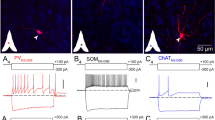Abstract
Pavlovian conditioning in Hermissenda produces a decrease in voltage-dependent (IK,A and ICa) and Ca2+-dependent (IK,Ca) currents, and an increase in the action potential (AP) duration in type B-photoreceptors. In addition, synaptic connections between B and A photoreceptors and B photoreceptor and type I interneurons are facilitated. The increase in AP duration, produced by decreasing one or more K+ currents, may account for synaptic facilitation. The present study examined this issue by using a mathematical model of the B-photoreceptor and the neurosimulator SNNAP. In the model, decreasing gK,A by 70% increased the duration of the AP in the terminal by 41% and Ca2+ influx by 30%. However, if the decrease in gK,A was combined with a decrease in gCa, similar to what has been reported experimentally, the Ca2+ influx decreased by 54%. Therefore, the concomitant change in ICa counter-acted the broadening-induced increase in Ca2+ influx in the synaptic terminal. This result suggests that a spike-duration independent process must contribute to the synaptic facilitation observed following Pavlovian conditioning.
Similar content being viewed by others
References
Acosta-Urquidi J, Crow T (1995) Characterization of voltageactivated currents in Hermissenda type B-photoreceptors. J. Neurosci. 15: 319-332.
Alkon DL, Sakakibara M, Forman R, Harrigan J, Lederhendler I, Farley J (1985) Reduction of two voltage-dependent K+ currents mediates retention of a learned association. Behav. Neural. Biol. 44: 278-300.
Alkon DL, Shoukimas JJ, Heldman E (1982) Calcium-mediated decrease of a voltage-dependent potassium current. Biophys. J. 40: 245-250.
Baxter DA, Byrne J (1989) Serotonergic modulation of two potassium currents in the pleural sensory neurons of Aplysia. Neurophysiol. 62: 665-679.
Baxter DA, Cai Y, Brembs B, Byrne JH (2000) Simulating physiological and morphological properties of neurons with SNNAP (Simulator for Neural Networks and Action Potentials). Soc. Neurosci. Abstr. 26: 45.
Bertram R, Smith GD, Sherman A (1999) Modeling study of the effects of overlapping Ca2+ microdomains on neurotransmitter release. Biophys. J. 76: 735-750.
Blackwell KT, Alkon DL (1999) Ryanodine receptor modulation of in vitro associative learning in Hermissenda crassicornis. Brain Res. 822: 114-125.
Byrne JH, Kandel ER (1996) Presynaptic facilitation revisited: State and time dependence. J. Neurosci. 16: 425-435.
Cai Y, Baxter DA, Crow T (2003) Computational study of enhanced excitability in Hermissenda: membrane conductances modulated by 5-HT. J. Comput. Neurosci. 15: 105-121.
Cai Y, Flynn M, Baxter DA, Crow T (2002) Changes in spike width in the soma may not reflect changes in the axon. Soc. Neurosci. Abstr. 28: 446.19.
Calabrese RL, Hill AAV, van Hooser SD (2001) Realistic modeling of small neuronal circuits. In: E De Schutter, ed. Computational Neuroscience: Realistic Modeling for Experimentalists, 1st ed. CRC Press, New York. pp. 271-272.
Collin C, Ikeno H, Harrigan JF, Lederhendler I, Alkon DL (1988) Sequential modification of membrane currents with classical conditioning. Biophys. J. 54: 955-960.
Crow T, Tian LM (2002) Facilitation of monosynaptic and complex PSPs in type I interneurons of conditioned Hermissenda. J. Neurosci. 22: 7818-7824.
Flynn MC, Cai Y, Baxter DA, Crow T (2001) Computational study of Hermissenda B-photoreceptors. II: Role of action potential duration in synaptic facilitation. Soc. Neurosci. Abstr. 27: 2532.
Fost JW, Clark GA (1996) Modeling Hermissenda: I. Differential contributions of IA and IC to type-B cell plasticity. J. Comput. Neurosci. 3: 137-153.
Frysztak RJ, Crow T (1994) Enhancement of type B and A photoreceptor inhibitory synaptic connections in conditioned Hermissenda. J. Neurosci. 14: 1245-1250.
Frysztak RJ, Crow T (1997) Synaptic enhancement and enhanced excitability in presynaptic and postsynaptic neurons in the conditioned stimulus pathway of Hermissenda. J. Neurosci. 17: 4426-4433.
Gandhi CC, Matzel LD (2000) Modulation of presynaptic action potential kinetics underlies synaptic facilitation of type B photoreceptors after associative conditioning in Hermissenda. J. Neurosci. 20: 2022-2035.
Gingrich KJ, Baxter DA, Byrne JH (1988) Mathematical model of cellular mechanisms contributing to presynaptic facilitation. Brain Res. Bull. 21: 513-520.
Hayes RD, Byrne JH, Baxter DA (2003). Neurosimulation: Tools and resources. In: M.A. Arbib, ed. The Handbook of Brain Theory and Neural Networks, 2nd ed. The MIT Press, Cambridge, MA, pp. 776-780.
Hochner B, Klein M, Schacher S, Kandel ER (1986) Additional component in the cellular mechanism of presynaptic facilitation contributes to behavioral dishabituation in Aplysia. Proc. Natl. Acad. Sci. USA 83: 8794-8798.
Luscher CR, Nicoll A, Malenka RC, Muller D (2000) Synaptic plasticity and dynamic modulation of the postsynaptic membrane. Nat. Neurosci. 3: 545-550.
Schuman EM, Clark GA (1994) Synaptic facilitation at connections of Hermissenda type B photoreceptors. J. Neurosci. 14: 1613-1622.
Sugita S, Baxter DA, Byrne JH (1997) Differential effects of 4-aminopyridine, serotonin, and phorbol esters on facilitation of sensorimotor connections in Aplysia. J. Neurophysiol. 77: 177-185.
Wu XS, Wu LG (2001) Protein kinase c increases the apparent affinity of the release machinery to Ca2+ by enhancing the release machinery downstream of the Ca2+ sensor. J. Neurosci. 21: 7928-7936.
Yamoah EN, Crow T (1994) Two components of calcium currents in the soma of photoreceptors of Hermissenda. J. Neurophysiol. 72: 1327-1336.
Yamoah EN, Matzel L, Crow T (1998) Expression of different types of inward rectifier currents confers specificity of light and dark responses in type A and B photoreceptors of Hermissenda. J. Neurosci. 18: 6501-6511.
Ziv I, Baxter DA, Byrne JH (1994) Simulator for neural networks and action potentials: Description and application. J. Neurophysiol. 71: 294-308.
Author information
Authors and Affiliations
Rights and permissions
About this article
Cite this article
Flynn, M., Cai, Y., Baxter, D.A. et al. A Computational Study of the Role of Spike Broadening in Synaptic Facilitation of Hermissenda . J Comput Neurosci 15, 29–41 (2003). https://doi.org/10.1023/A:1024418701765
Issue Date:
DOI: https://doi.org/10.1023/A:1024418701765




